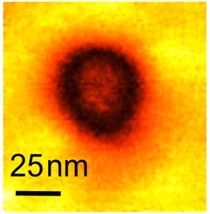ORNL experiments prove nanoscale metallic conductivity in ferroelectrics

ORNL researchers used piezoresponse force microscopy to demonstrate the first evidence of metallic conductivity in ferroelectric nanodomains. A representative nanodomain is shown in the PFM image above.<br>
Ferroelectric materials, which switch their polarization with the application of an electric field, have long been used in devices such as ultrasound machines and sensors. Now, discoveries about ferroelectrics' electronic properties are opening up possibilities of applications in nanoscale electronics and information storage.
In a paper published in the American Chemical Society's Nano Letters, the ORNL-led team demonstrated metallic conductivity in a ferroelectric film that otherwise acts as an insulator. This phenomenon of an insulator-metal transition was predicted more than 40 years ago by theorists but has eluded experimental proof until now.
“This finding unambiguously identifies a new conduction channel that percolates through the insulating matrix of the ferroelectric, which opens potentially exciting possibilities to 'write' and 'erase' circuitry with nanoscale dimensions,” said lead author Peter Maksymovych of ORNL's Center for Nanophase Materials Sciences.
From an applied perspective, the ability to use only an electric field as a knob that tunes both the magnitude of metallic conductivity in a ferroelectric and the type of charge carriers is particularly intriguing. Doing the latter in a semiconductor would require a change of the material composition.
“Not only can we turn on metallic conductivity, but if you keep changing the bias dials, you can control the behavior very precisely,” Maksymovych said. “And the smaller the nanodomain, the better it conducts. All this occurs in the exact same position of the material, and we can go from an insulator to a better metal or a worse metal in a heartbeat or faster. This is potentially attractive for applications, and it also leads to interesting fundamental questions about the exact mechanism of metallic conductivity.”
Although the researchers focused their study on a well-known ferroelectric film called lead-zirconate titanate, they expect their observations will hold true for a broader array of ferroelectric materials.
“We also anticipate that extending our studies onto multiferroics, mixed-phase and anti-ferroelectrics will reveal a whole family of previously unknown electronic properties, breaking new ground in fundamentals and applications alike,” said co-author and ORNL senior scientist Sergei Kalinin.
The samples used in the study were provided by the University of California at Berkeley. Co-authors on the paper are ORNL's Arthur Baddorf, UC Berkeley's Ying-Hao Chu, Ramamoorthy Ramesh and Pu Yu, and National Academy of Science of Ukraine's Eugene Eliseev and Anna Morozovska. The full paper, “Tunable Metallic Conductance in Ferroelectric Nanodomains,” is available at http://pubs.acs.org/doi/full/10.1021/nl203349b.
Part of this work was supported by the Center for Nanophase Materials Sciences at ORNL. CNMS is one of the five DOE Nanoscale Science Research Centers supported by the DOE Office of Science, premier national user facilities for interdisciplinary research at the nanoscale. Together the NSRCs comprise a suite of complementary facilities that provide researchers with state-of-the-art capabilities to fabricate, process, characterize and model nanoscale materials, and constitute the largest infrastructure investment of the National Nanotechnology Initiative. The NSRCs are located at DOE's Argonne, Brookhaven, Lawrence Berkeley, Oak Ridge and Sandia and Los Alamos national laboratories. For more information about the DOE NSRCs, please visit http://science.energy.gov/bes/suf/user-facilities/nanoscale-science-research-centers/. Work at the University of California, Berkeley, was supported by DOE's Office of Science and the Semiconductor Research Corporation. ORNL is managed by UT-Battelle for the Department of Energy's Office of Science.
Media Contact
More Information:
http://www.ornl.govAll latest news from the category: Materials Sciences
Materials management deals with the research, development, manufacturing and processing of raw and industrial materials. Key aspects here are biological and medical issues, which play an increasingly important role in this field.
innovations-report offers in-depth articles related to the development and application of materials and the structure and properties of new materials.
Newest articles

A universal framework for spatial biology
SpatialData is a freely accessible tool to unify and integrate data from different omics technologies accounting for spatial information, which can provide holistic insights into health and disease. Biological processes…

How complex biological processes arise
A $20 million grant from the U.S. National Science Foundation (NSF) will support the establishment and operation of the National Synthesis Center for Emergence in the Molecular and Cellular Sciences (NCEMS) at…

Airborne single-photon lidar system achieves high-resolution 3D imaging
Compact, low-power system opens doors for photon-efficient drone and satellite-based environmental monitoring and mapping. Researchers have developed a compact and lightweight single-photon airborne lidar system that can acquire high-resolution 3D…





















